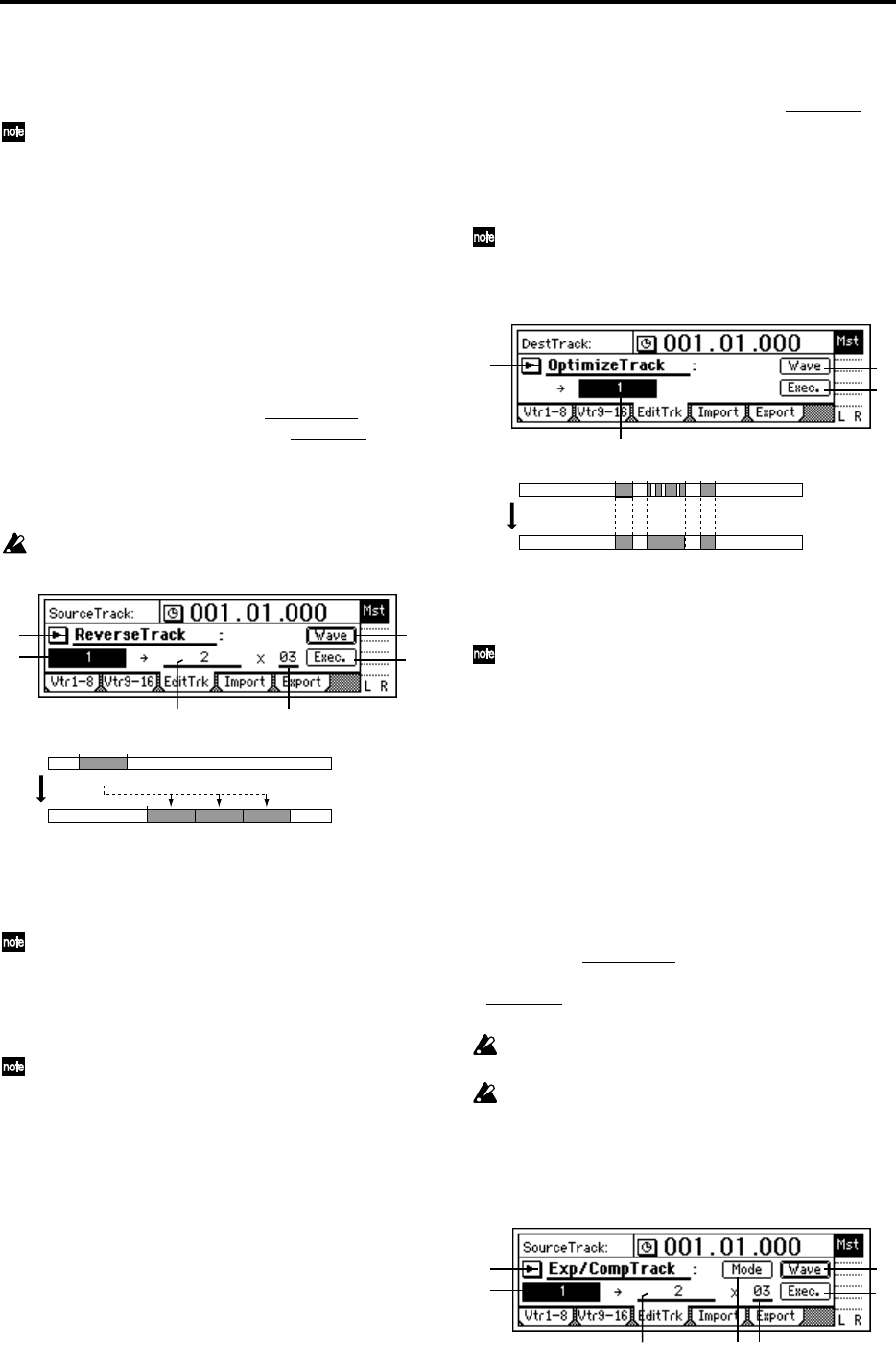
84
3. DestTrack................................................................
[1...16, 1–2...15–16, 1–4...13–16, 1–8, 9–16, 1–16]
Select the swap destination track.
In the case of a 24 bit song, only tracks 1–8 can be
selected.
4. Exec. (Execute)........................................................
Execute the track editing operation.
5. Wave .....................................................................
This displays the audio data of the track as a wave-
form. Here you can set the editing locations (IN,
OUT, TO) more precisely. (→p.82 EditType: “Copy-
Track”)
EditType: “ReverseTrack”
This operation copies the track data of the IN–OUT
range of the reverse source track (“Sour
ceTrack”) to the
TO location of the destination track (“DestT
rack”) in
reverse (flipped back-to-front). You can specify the
number of times that the data will be copied.
When this is executed (“Exec.”), the copied data will be
reversed, so that the playback will be backward.
The specified range of the reverse destination track
will be overwritten.
2. SourceTrack ............................................................
[1...16, 1–2...15–16, 1–4...13–16, 1–8, 9–16, 1–16]
Select the reverse source track.
In the case of a 24 bit song, only tracks 1–8 can be
selected.
3. DestTrack................................................................
[1...16, 1–2...15–16, 1–4...13–16, 1–8, 9–16, 1–16]
Select the reverse copy destination track.
In the case of a 24 bit song, only tracks 1–8 can be
selected.
4. Times........................................................... [1...99]
Specify the number of times that the data will be
copied.
5. Exec. (Execute)........................................................
Execute the track editing operation.
6. Wave .....................................................................
This displays the audio data of the track as a wave-
form. Here you can set the editing locations (IN,
OUT, TO) more precisely. (→p.82 EditType: “Copy-
Track”)
EditType: “OptimizeTrack”
This operation optimizes the track data of the IN–OUT
range of the optimize destination track (“DestT
rack”).
The D1600 will not generate unnecessary sound if the
IN–OUT range contains unused blank portions. How-
ever in the case of brief blank portions that are close to
the next audio event, the data will be generated as a
single sound to avoid producing “DiskBusy” errors.
By executing Optimize Track with IN–OUT set to
the beginning and end of the song, you can ensure
that the data will be accessed with optimal effi-
ciency from the hard disk.
2. DestTrack ................................................................
[1...16, 1–2...15–16, 1–4...13–16, 1–8, 9–16, 1–16]
Select the track that will be optimized.
In the case of a 24 bit song, only tracks 1–8 can be
selected.
3. Exec. (Execute) ........................................................
Execute the track editing operation.
4. Wave......................................................................
This displays the audio data of the track as a wave-
form. Here you can set the editing locations (IN,
OUT, TO) more precisely. (→p.82 EditType: “Copy-
Track”)
EditType: “Exp/CompTrack”
This operation expands or compresses the track data of
the IN–OUT range of the expansion/compression
source track (“Sour
ceTrack”), places it in the TO–END
range of the expansion/compression destination track
(“DestT
rack”), and copies it the specified number of
times beginning at the TO location.
When this is executed (“Exec.”), the expansion/
compression destination track will be overwritten.
The available ratio of expansion/compression is
limited, and if the IN–OUT duration is drastically
different than the TO–END duration, an error mes-
sage will appear when this is executed. In general,
the TO–END time can be changed to 50–200% of
the IN–OUT time.
1 6
5
2
3
4
A B C ...
A B C ...A B C ...A B C ...
IN OUT
TO
SourceTrack
DestTrack
TIMES
1
3
4
2
IN OUT SourceTrack
DestTrack
1 6
5
2
3
47


















